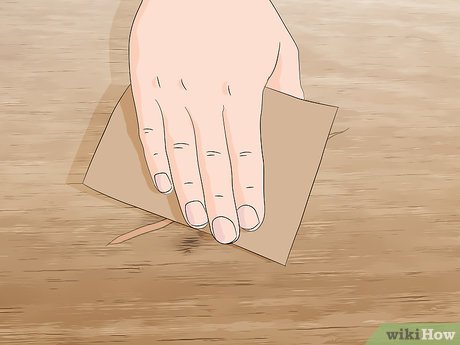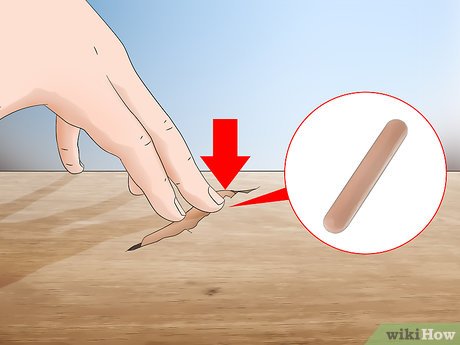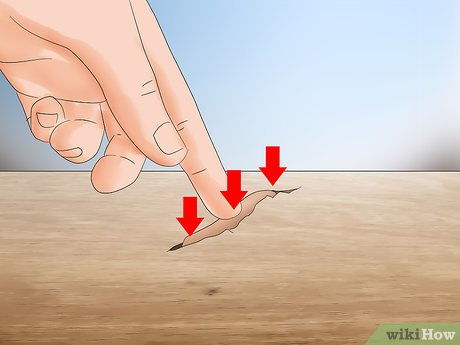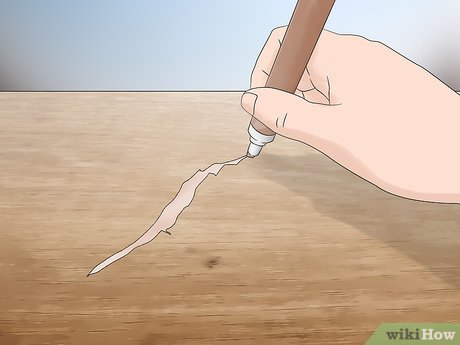Заделывание Трещин в Деревянных Изделиях: 3 Способа — wikiHow
Though cracks are unappealing, there are plenty of products available that can save a damaged piece of wood. Wood putty or wood filler sticks are easy to use and effective for covering over wide cracks in indoor and unstained wood. For a quick fix, a mixture of wood glue and sawdust seamlessly blends in small cracks and gaps in assembled furniture. Purchase epoxy to handle larger gaps, such as on outdoor projects. After some blending and sanding, no one will notice the damaged area you patched.
-
Purchase a filler compound that’s the same color as the wood. Look for crayon-shaped wood filler sticks or wood putty. These products, purchased from home improvement stores or ordered online, come in a variety of colors. Pick the one that blends in best with the wood you’re treating.[1]
- If you can’t find the exact shade you need, you can buy different colors and mix them together to create different shades.
- If you wish to color the wood later, make sure the label says the product is stainable. It’ll take on the color of the stain, blending in with the wood.
-
Push the filler into the hole with your finger. If you’
Если вы используете стикер для заделки, просто протрите его над трещиной. При необходимости вы можете распределить его пальцем по поверхности. При использовании шпателя или резца можно распределить шпаклевку по трещине. Помните, что это вещество не следует вдыхать, поэтому обязательно наденьте маску перед началом работы. Работа на свежем воздухе будет самым безопасным вариантом, и убедитесь, что домашние животные и члены семьи не находятся рядом с рабочей областью.

Advertisement
-
Overfill the crack with filler material. Continue applying filler until it comes out the top of the crack. When you smooth and sand the filler later, it’ll blend the crack more effectively because of the overfill.[2]
-
Smooth the filler with a putty knife. Before the material dries on the wood, flatten it out as much as possible. If you don’t have a putty knife, run a clean rag or your finger over the crack. Make sure the rag is clean to avoid introducing debris.[3]
-
Let the wood filler dry for 8 hours. The amount of time needed for the filler material to dry depends on the product, so check the label for the recommended wait time. To be safe, leaving the wood alone for 8 hours or overnight will ensure the filler dries completely.[4]
-
Sand down the excess filler. Blend the cracked area with a plane or fine grit sandpaper. Aim for a sandpaper grit between 120 and 220. Wear away the filler until it’s as flat against the wood as you can make it. When finished, the crack shouldn’t stand out as a discolored patch.[5] If it does, lightly go over it with a matching color stain.
Advertisement
-
Get sawdust that matches the type and color of your wood. Sawdust is used to cover the white glue and blend the crack, so it needs to match the wood you’re treating as much as possible. For the best blend, get some sawdust from the wood by sawing or sanding it.
- When this isn’t possible, purchase a bag of sawdust from a home improvement store.
-
Squeeze wood glue into the crack. Get a bottle of wood glue from the store. Press the nozzle against the crack and squeeze the container until the glue fills the entire space you need to repair. For small cracks, you may also use a syringe to ensure the glue gets all the way down inside the crack.[6]
-
Cover the glue with sawdust. Layer a lot of sawdust over the glue to completely cover it. Rub your finger over the crack to ensure the glue holds the sawdust in place. When you’re finished, the sawdust should hide the glue from view, blending in with the rest of the wood.[7]
-
Let the glue dry overnight. Leave the glue to rest until the next day. When the glue is completely dried, the crack should be hard to see. If it’s still visible, reapply the glue and sawdust combination or a different filler.[8]
-
Sand the crack smooth. Go over the crack with a piece of fine grit sandpaper that’s between 120 and 220 grit. Carefully rub down the treated area until the filler is flat and unnoticeable.[9]
Advertisement
-
Wear a respirator mask and work in a well-ventilated area. Epoxy isn’t something you want to breathe in, so stay safe by putting on a mask before you begin. Working outdoors is your safest option, and make sure pets and family members aren’t near your work area.[10]
-
Cover the crack with masking tape if it goes through the wood. If the crack goes all the way through the wood, tape over one side. The tape will hold the liquid epoxy in place long enough for it to solidify.[11]
- Epoxy is better for treating large cracks than the other filler methods.
-
Squirt equal parts of epoxy components into a bowl. Epoxy consists of two parts packaged together, resin and hardener. Estimate how much you’ll need to fill the crack. Add them to the bowl, but don’t mix them yet.[12]
- The epoxy immediately begins to harden when the parts are combined. You’ll have about 5 minutes to get it into the crack, so start with a small batch.
-
Add a drop of wood-colored dye to the epoxy. At home improvement stores you can usually find all sorts of epoxy coloring dyes, powdered pigments, or metallic powders. Pick one that matches your project, then use a drop of dye or sprinkle of powder to color the epoxy.[13]
- You can even mix in a scoop of coffee grounds to turn the epoxy black.[14]
-
Stir the epoxy immediately. Grab a spoon or stirring stick and quickly mix the epoxy parts together, along with any added coloring. After a few seconds it’ll turn into a paint-like substance ready to be spread over the crack.[15]
-
Spoon the mixture into the crack. Transfer the epoxy to the crack using the stirring spoon or stick. Push it as far into the crack as possible. Most of it will flow down to the bottom. If you don’t have enough to fill the entire crack, simply make more.
- Use a needle to pop any bubbles that appear when pouring the epoxy.
-
Mix more epoxy to fill larger cracks. The epoxy hardens within minutes, so you’ll know right away whether or not you need to mix another batch. Continue mixing equal amounts of resin and hardener until you’ve filled the entire crack.[16]
-
Let the epoxy dry overnight. After 2 to 4 hours, the epoxy will have dried significantly. Press your fingernail into it. If you leave a dent, it’s not ready. Letting it dry overnight is always preferable and, in cool weather, is necessary to ensure that the epoxy stays in place.[17]
-
Level the epoxy with sandpaper. First, cut away any excess epoxy with a putty knife. Then get some fine grit (120-220) sandpaper or a file to carefully flatten the epoxy-treated area until it’s level with the rest of the wood.[18]
- If you have a block plane, it’ll make this part easier and can prevent you from sanding off part of the wood.
-
Color in white specks with a felt tip marker. When you’re finished, you may see some undyed flecks of hardened epoxy. These can be colored in with any marker that’s a similar color to the dye you used. You won’t even know the crack was there and can move on to the rest of your project.
Advertisement
-
Question
I’m using epoxy resin to seal a crack in wood. Masking tape did not work, and resin leaked out within minutes. What kind of tape would be best to use?
Terry Heaps
Community Answer
I’ve always used a product called «Plastic Wood.» for all my crack and nail hole puttying. It is the best product in my estimate. With that being said, any hardware store will carry «Frog Tape.» It’s green in color and sticks to any semi-smooth surface very well. Painters and carpenters love the stuff because nothing will seep under it. Pulling it off leaves a nice clean sharp line.
-
Question
When using epoxy resin, what kind of tape should I use to seal off the underside of a wood crack?
Use plastic, wood or frog tape. You can buy them at hardware stores.
-
Question
I have a tongue and groove 2×6 raw wood floor that has dried and shrunk. What should I fill the gaps in with? I want to paint the floor after I fill the gaps.
You can buy floor leveler, of the type used to level floors before laying vinyl. Fill in the cracks, then sand level.
Ask a Question

200 characters left
Include your email address to get a message when this question is answered.
Advertisement
-
Use denatured alcohol to clean epoxy off of surfaces and utensils.
-
Vinegar can be used to remove epoxy from skin.
Advertisement
-
Sanding wood leaves wood particles in the air. Wear a respirator to avoid inhaling them.
-
Working with chemicals can be dangerous. Wear a respirator and work in a well-ventilated area.
Advertisement
Things You’ll Need

- Wood putty or filler stick
- Putty knife
- Sandpaper
- Wood glue
- Sawdust
- Sandpaper
- Respirator mask
- 2-part liquid epoxy (resin and hardener)
- Dye or pigment
- Mixing cup
- Stirring utensil
- Needle or pin
- Masking tape
- Dye-colored marker
- Sandpaper
References
About This Article
To fill in cracks start by purchasing a filler compound that’s the same color as the wood, so it blends in. Using your finger, push filler into the hole until it’s slightly overflowing, then smooth it down with a putty knife. Once it’s dry, which should take about 8 hours, sand down any excess filler using fine-grit sandpaper. Alternatively, if you want to fill cracks in wood with glue and sawdust, start by getting sawdust that matches the type and color of your wood. Then, fill the crack with wood glue and sprinkle the sawdust on top until the glue is completely covered. From here, simply wait for the glue to dry overnight, then sand the crack smooth with sandpaper. For more tips, including how to fix cracks in wood with epoxy, read on!
Did this summary help you?
Thanks to all authors for creating a page that has been read 227,161 times.

Did this article help you?
Чем заделать трещины в бревнах деревянного дома?
Для заделки трещин в бревнах деревянного дома можно использовать различные материалы в зависимости от размера и глубины трещин:
-
Шпаклевка для дерева: мелкими трещинами можно заделать с помощью специальной шпаклевки для дерева. Это материал, который состоит из древесной муки и связующего, обладает хорошей адгезией и легко наносится на поверхность бревна.
-
Эпоксидная смола: при наличии больших трещин можно использовать эпоксидную смолу. Она обладает высокой прочностью и устойчивостью к влаге и ультрафиолетовому излучению. При нанесении эпоксидной смолы на поверхность бревна, необходимо убедиться, что поверхность сухая и чистая.
-
Шерстяной шнур: если трещина слишком широкая, чтобы ее можно было заделать шпаклевкой или эпоксидной смолой, можно использовать шерстяной шнур. Его вставляют в трещину и затем заполняют теснительным составом, который может быть сделан из глины, цемента или других материалов.
-
Деревянные шайбы: для заделки трещин между бревнами можно использовать деревянные шайбы. Они закладываются в прорези между бревнами, что позволяет сохранить эстетику и естественный вид деревянного дома.
Важно убедиться, что поверхность, которую вы собираетесь заделать, сухая и чистая. Для лучшей адгезии материала к поверхности можно использовать грунтовку.